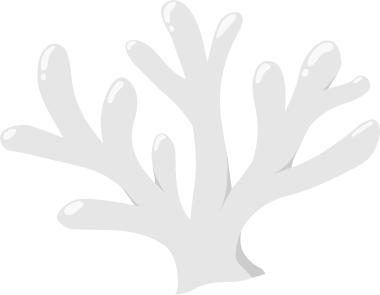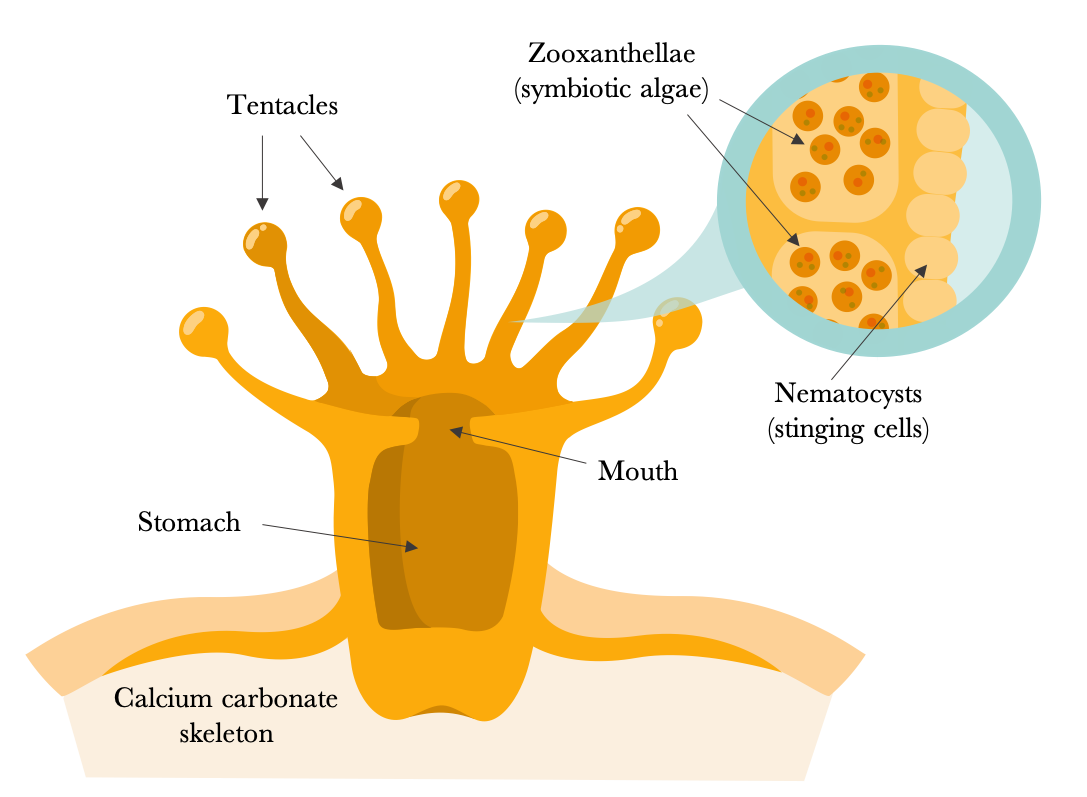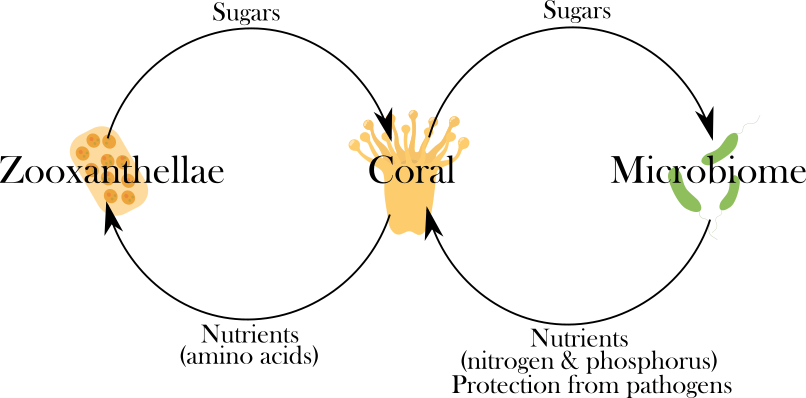Coral Bleaching Is Far More Complex Than We First Thought. Here's Why That Matters.
A detailed look into why coral reefs are dying.

This blog post is part one of two, where I discuss current research into coral reefs. In this first part, I give an introduction to coral reefs, what reef bleaching is, and why they bleach. The second part will discuss the work of scientists researching unique methods to try and save these beautiful ecosystems. Stay tuned for part two!
Why Corals are Important
Coral reefs provide food for millions of people living on the coast, and generate billions of dollars of income from tourism worldwide [1]. They're not only pretty to look at, but they actually protect coastlines from storms, and help enable the formation of fisheries and other habitats such as mangroves.
As sea temperatures increase due to global warming, coral reefs undergo a process known as bleaching. Simply put: the symbiotic algae living inside corals die, which makes the coral turn white and eventually die, too. This means that if the oceans continue to get warmer, coral habitats like the Great Barrier Reef may struggle to recover from bleaching in the future.
To understand how bleaching will affect corals in the future, we need to go deeper into how corals work, and what makes them bleach.
Coral Biology 101
You may not know it, but coral is not just a single organism. It's a collection of organisms, all working together, called a holobiont. The holobiont is what we typically think of when we see those beautiful, colourful photographs of corals.

The holobiont is mainly two species: the coral organism, and a microscopic algae often called a zooxanthellae [2]. This algae is incredibly important for the coral because, like plants, the algae makes energy from the sun through photosynthesis, and passes that energy to the coral in the form of sugars, like glucose. In return, the coral gives the algae protection, amino acids, and important nutrients like nitrogen and phosphorus.
When a coral bleaches, this is because the algae have either died, or abandoned the coral. The algae often have very bright photosynthetic pigments, which give the corals their incredible colours. Dead algae means that the corals lose that colour and turn white, in other words, 'bleaching'.

So, What Actually Causes Coral Bleaching?
When we say corals are bleached, we're talking about the death of their algae (zooxanthellae) because of a process called photoinhibition, which affects the way the algae performs photosynthesis. Photoinhibition is both temperature- and light- dependent. Under normal temperatures, the zooxanthellae capture energy in the form of sunlight and produce oxygen via the so-called 'light reactions'. They pass this light energy to other parts of the cell, to be processed by the 'dark reactions'. These dark reactions then use carbon dioxide from the atmosphere to make glucose, which feeds the algae and the coral.
Under high ocean temperatures, the dark reactions become inhibited, and can no longer receive the light energy being passed from the light reactions. Because of this, the light reactions start producing deadly chemicals called 'Reactive Oxygen Species', which ultimately damage and kill the algae. Bleaching can also occur at normal temperatures in corals, due to high light intensities (such as in shallow water), which often bleach the tips of corals. However, in high temperatures, the amount of light needed to bleach coral is lowered, meaning that bleaching occurs even at normal light intensities [1].

So far, it would seem that the only way we can stop coral reefs from bleaching entirely is to decrease the temperature of the oceans, or maybe even prevent them from getting too much light. But as is often the case, this isn't the whole picture. It turns out, as scientists discovered in the early 2000s, that coral holobionts don't just consist of the coral animal and the algae. Corals are actually also home to thousands of micro-organisms, mainly bacteria, who live in a thick mucus layer secreted by the coral. Collectively, these micro-organisms are known as the coral microbiome.
The Coral Microbiome
Microbiome research has been really popular in the news recently, especially as we learn more about human gut bacteria and how they affect our health. Just as our microbiome has a huge influence on us, corals too are influenced by the many bacteria which live on them and inside them.

Coral-Killing Bacteria
One of the more well-known bacteria associated with corals was discovered in 2002, and is named Vibrio corallilyticus [4]. If it sounds menacing, that's because it is! This bacteria is fascinating because, at lower temperatures, it lives quite happily side-by-side with the corals. However, at temperatures above 25°C, the bacteria becomes too abundant and turns pathogenic, killing the coral it lives upon [6]. Unfortunately, with ocean temperatures continuing to rise, it's possible that Vibrio corallilyticus will continue to wreak havoc on coral reefs.
Coral Probiotics?
Luckily, not all coral-associated bacteria are harmful. Since the discovery of the coral microbiome, many scientists have been working on the Coral Probiotic Hypothesis. Just as humans can drink probiotic yoghurt to help our gut microbiome, corals can in theory be given beneficial bacteria to help combat the harmful ones. The difficulty lies in figuring out the helpful from the harmful, and how exactly to get the good bacteria to the corals in the first place.
In part two of this blog post, we'll look at some of the recent work of scientists trying to do just that.
Sources for the EcoCurious
- Hoegh-Guldberg, O. (1999). Climate change, coral bleaching and the future of the world’s coral reefs. Marine and Freshwater Research, 50(8), 839–866. https://doi.org/10.1071/MF99078 Link
- Zooxanthellae… What's That? (NOAA Webpage) https://oceanservice.noaa.gov/education/kits/corals/coral02_zooxanthellae.html
- Rohwer, F., Seguritan, V., Azam, F., & Knowlton, N. (2002). Diversity and distribution of coral-associated bacteria. Marine Ecology Progress Series, 243, 1–10. https://doi.org/10.3354/meps243001 Link
- Ben-Haim, Y., & Rosenberg, E. (2002). A novel Vibrio sp. pathogen of the coral Pocillopora damicornis. Marine Biology, 141(1), 47–55. https://doi.org/10.1007/s00227-002-0797-6 Link
- Reshef, L., Koren, O., Loya, Y., Zilber-Rosenberg, I., & Rosenberg, E. (2006). The Coral Probiotic Hypothesis. Environmental Microbiology, 8(12), 2068–2073. https://doi.org/10.1111/j.1462-2920.2006.01148.x Link
- Ben-Haim, Y., Thompson, F. L., Thompson, C. C., Cnockaert, M. C., Hoste, B., Swings, J., & Rosenberg, E. (2003). Vibrio coralliilyticus sp. nov., a temperature-dependent pathogen of the coral Pocillopora damicornis. International Journal of Systematic and Evolutionary Microbiology, 53(1), 309–315. https://doi.org/10.1099/ijs.0.02402-0 Link


